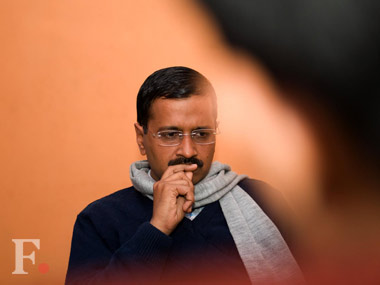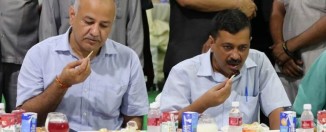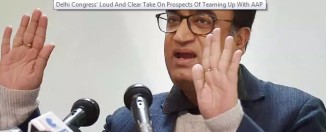Target 2019: Kejriwal’s anti-Modi moves are rooted in his ambition
Like always, there is a method to Arvind Kejriwal‘s madness.
Being the shrewd and ambitious politician he is, the Delhi chief minister has realised that the space for an anti-establishment leader has started growing again in India. And he is making fast and furious moves to occupy the slot before anyone else becomes the pivot of the anti-BJP politics that could become a rewarding pursuit by 2019.
Slowly, but perceptibly, Indian politics is coming full circle, tracing back the journey that had begun at the turn of the decade. Hope in the government that was voted in with a lot of expectations has begun to dilute, the prime minister’s popularity has plateaued and, if results of the recent elections in Bihar and Gujarat are an indication, may now be on the decline.
The economy has come to a standstill. Growth forecasts have become sobre and sombre: the latest estimate has been revised downwards to 7-7.5 percent from the previous 8.1-8.5 percent. Reforms are stuck, legislative bills are caught in politics of hostility, jobs are not rising, prices — not the ones reflected on indices of data crunchers but on grocery lists of real people — are going through the roof. There is a general atmosphere of hostility and distrust. Promises of achche dinhave become a painful memory, memories of 2010 are sneaking back into the collective conscience on tip toe.
All this may not be visible to those who believe that the Narendra Modi government has lived up to expectations and still inspires hope. But, within a year, unless something dramatic happens, a string of electoral results could change the mood on the ground dramatically.
Bihar has slipped from the BJP’s grasp. The party never had a realistic chance in Tamil Nadu and Kerala, where elections are due next, but it had once set its heart on winning West Bengal after the encouraging results of the 2014 Lok Sabha polls. But Vidhan Sabha polls are unlikely to reflect the optimism of the post-2014 triumph.
In Punjab, the Akali Dal-BJP alliance is facing stiff challenge after ten years of incumbency. The trends in 2014, when both the Congress and the AAP did well in spite of the Modi wave, was a trailer of the 2017 show. But since then, things have gone from bad to worse and the ruling alliance is staring at a drubbing in Punjab that could be more severe than the beating in Delhi.
Even die-hard supporters of the BJP would find it difficult to answer this question: Where is the party winning next? Perhaps Assam, but every other state election appears a tough challenge.
In his book on the 2014 election, How Modi Won It, senior journalist and former media advisor to PM Manmohan Singh, Harish Khare quotes poet Ashok Vajpayee to raise an interesting question: “We have all been told he is coming/… It is difficult to say if he is imposing himself, or/If the masses are propping him up…” Implicit in the dilemma is the importance of favorable circumstances in the rise of a politician, triumph of an idea whose time has come.
He then goes on to argue that the circumstances between 2010 and 2013 had made the demise of UPA 2 inevitable. Modi benefitted from this mood for change fueled by universal frustration with and anger against the establishment by propping himself up as the perfect alternate.
Just before the 2014 polls, even Kejriwal had sensed an opportunity to channel the all-pervading resentment against the UPA into an electoral victory. But, by the time he entered the fray, Indians had already invested heavily in Modi as the antidote to the UPA. By getting the timing wrong, Kejriwal almost perished.
So, this time he has started early in his quest to become the Modi of 2019.
For the past few days, Kejriwal has been relentlessly attacking the PM and his finance minister with the hope of becoming the leading anti-Modi voice in the country. By punching well above his weight, just like Modi did as chief minister of Gujarat, he is hoping to become the symbol of anti-establishment by the time the next election is around.
After his victory in Delhi, many had argued that the result was not a manifestation of an anti-Modi mood in the national capital. Most of it was credited to the voter’s decision to have Modi as PM and Kejriwal as CM, of having the proverbialladdoo in both hands.
Since then, with his shrill anti-Modi rhetoric, Kejriwal has erased the impression of being an adjunct to Modi’s politics to position himself as an alternative. His success in creating this distinction can be gauged from the fact that for a bhakt, even the idea of voting for Kejriwal today would be blasphemy.
Many of Kejriwal’s critics have called him a glorified mayor. He has been handicapped also because of his inability to get crucial decisions past the Delhi Lt Governor’s desk. But, Kejriwal could soon get an opportunity to get rid of these handicaps.
In Punjab, where elections are due in January 2017, the incumbent SAD-BJP government is facing a decade of anti-incumbency and dissatisfaction with the Badal dynasty. In all probability, the NDA will lose the election.
Kejriwal can progress in politics only if he wins Punjab, or at least puts up a strong show. It doesn’t look easy.
In Punjab, Kejriwal is facing the challenge of warding off the might of former chief minister and Congress leader CaptainAmarinder Singh. The mood on the ground suggests voters are torn between AAP and a resurgent Congress under Singh. Both have equal chances of replacing the SAD-BJP government.
Aware of the challenge and the opportunity, Kejriwal is planning to camp in Punjab for almost six months before the elections, leaving Delhi to his deputy Manish Sisodia. If he wins Punjab, demolishes the Badals and pins down Singh, Kejriwal will immediately fancy himself as a challenger to Modi.
Kejriwal’s rise, if it happens, won’t be a tragic development for the BJP. It will immediately bring his ambition into conflict with that of Rahul Gandhi, Mulayam Singh, Nitish Kumar — the current frontrunner — and other regional aspirants, immediately putting under strain the current index of opposition unity, the biggest threat to Modi after anti-incumbency.





